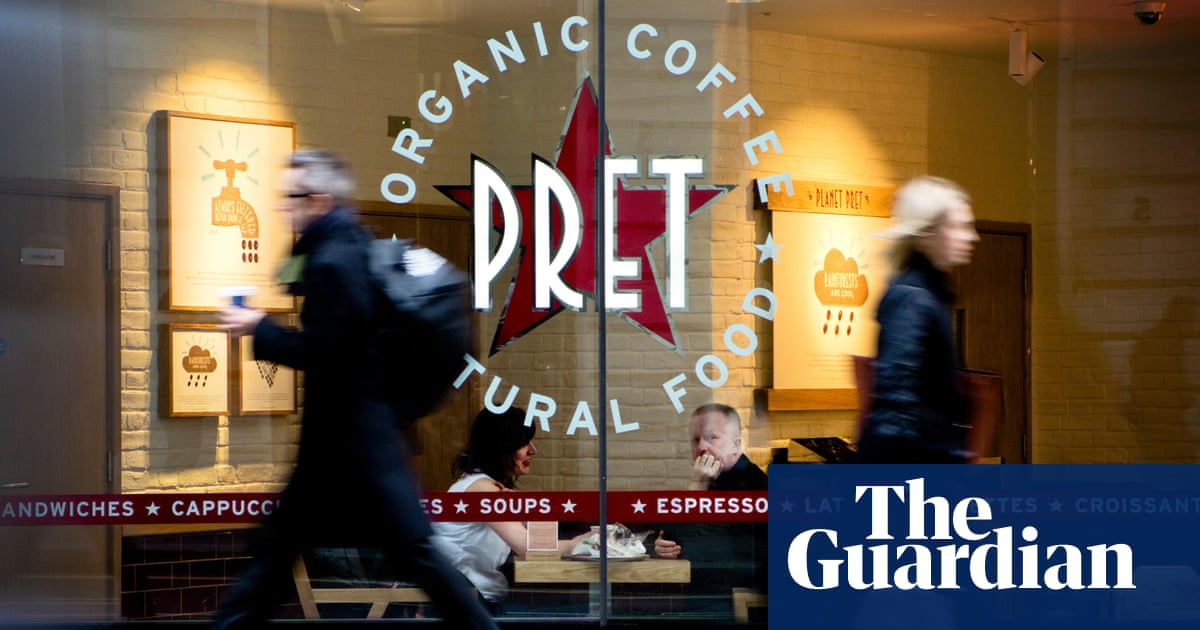At 93-95 Victoria Street, Westminster, a blue plaque marks a piece of London history: the first ever branch of Pret a Manger opened on this spot on 22 July 1986. Nearly 40 years later, it is still going strong.
It’s a nice story – but it’s not the whole story. Look closer and the plaque states that the first Pret sandwich shop opened “near here”. In fact, it was down the road, at 75b, now a branch of Toni & Guy. Except … that wasn’t the first shop, either. The original Pret opened two years earlier and five miles to the north, in Hampstead. It went bust after a year and the founder, Jeffrey Hyman, sold the name, branding and logo to Julian Metcalfe and Sinclair Beecham, who reopened in Westminster.
That rocky beginning has been airbrushed from company history. Does it matter? Well, maybe. Pret is skilled at putting a neat spin on complex realities.
Fast-forward to 2025 and London is packed with Prets. I meet Jack Chesher, the author of London: The Hidden Corners for Curious Wanderers, for a stroll through the City. As a historian, Chesher knows a lot about London’s early coffee houses; as a walking guide, he has witnessed first-hand the proliferation of Pret.
I see my first Prets of the day when I get on the tube at Finsbury Park, one near each entrance. I get out at Moorgate and immediately see another. I do a quick search on my phone – 20 Prets pop up on the map, all within a few minutes’ walk. I’m not surprised: there are 274 branches in London, far more than in any other city. Manchester has 14, Birmingham 10, Edinburgh nine; a handful of cities have six, including Glasgow, Leeds, Bristol and Oxford. This is in contrast to, say, Greggs, which has just 42 branches in London and many more in northern England and Scotland. Tamsyn Halm, the editor of OOH (Out of Home) magazine, says: “Pret has become synonymous with the capital. If you go to London, you need to go to Pret.”
Chesher and I meet at Leadenhall Market, which stands at what was once the centre of Roman London. There is no Pret in the market itself, but I spot one just outside, on Gracechurch Street. We head down an alley to the site of London’s first coffee house – now the Jamaica Wine House – which opened in 1652. Coffee houses quickly took off, says Chesher. It wasn’t about the coffee, which was described as a “syrup of soot and the essence of old shoes”, but the atmosphere. “These were buzzy, social spaces, where anyone from dockers to lawyers could go to read the newspapers and debate the issues of the day. They were known as penny universities.”
It’s a far cry from a typical Pret, where customers grab a coffee to go, or sit with a sandwich at their laptops, headphones in. Christopher Yap, a senior research fellow at the Centre for Food Policy at City, University of London, thinks this is a peculiarly British phenomenon. “The work-food culture prioritises a particular form of eating,” he says. A 2023 survey of 35,000 workers across 26 countries found that the average lunch break in the UK is just 33 minutes and almost half of employees eat lunch alone. “We don’t have a culture of eating communally. This puts us in contrast with other European countries,” says Yap.
What are all these harried, lonely Londoners buying from Pret? The latte (£3.80) is the bestseller and the top-selling foods are all baguettes: chicken caesar bacon, tuna mayo and cucumber, and cheddar and pickle. (I’m partial to a soy flat white and an avocado, olive and tomato baguette myself.) After criticism over rising prices, Pret made some cuts last year. That cheese and pickle baguette is down from £4.99 to £3.99, for example, and filter coffee is just 99p. Halm says: “This makes Pret a bit different to the crowd. No one else on the high street is giving away anything for less than a pound.”
Prices within London can vary, however – it is more expensive to eat in, while branches at airports or train stations are usually pricier than the high street. A £3.99 tuna baguette will set you back £4.50 in a “transport hub”. A spokesperson for Pret says: “This is due to higher rents and labour costs for those shops, as they usually require different working hours or higher security checks.”
As we wander through the City, we pass many other coffee-and-sandwich chains, but none appear with such regularity as Pret. Once my eye is attuned to its pub-style hanging sign – a white star on a maroon background – I start seeing it everywhere. We head down Fleet Street and Chesher points out one of London’s oldest pubs, Ye Olde Cheshire Cheese (rebuilt in 1667 after the Great Fire). Right next to it? Pret. We continue on to the Strand and stop at Twinings, the oldest tea shop (opened 1706). The former bank next door? You guessed it – Pret.
How does a sandwich shop afford such prime real estate? Pret, unsurprisingly, stopped being a two-man operation long ago. McDonald’s bought a 33% stake in the company in 2001. The fast food giant sold its stake to the private equity firm Bridgepoint Capital in 2008, which became the majority shareholder. Bridgepoint, in turn, sold Pret to JAB Holdings, a Luxembourg-based investment fund belonging to Germany’s billionaire Reimann family, in 2018 for a reported £1.5bn. All 12,000 Pret employees received a £1,000 payout. (In an interview last year, the CEO, Pano Christou, said staff are paid more than the London Living Wage, including bonuses.)
After losses during the pandemic, Pret returned to profitability in 2022. UK sales in 2023 were up 18% year on year; the latest global figures, from the first half of 2024, show a 10% increase, to £569m. “After Covid, Pret has been on an extreme mission to grow,” says Halm. Its locations – on high streets, by offices, in train stations, at airports – make it very accessible. “Yes, the high street might look samey, but that’s how you establish quality,” she says. “People want premium options that are reliably good.”
Chris Young, the coordinator of the Real Bread Campaign, is more sceptical: “Chains can plug a gap in a high street, although typically they don’t go to a failing high street. It’s like the Starbucks effect in the 90s – it would target successful cafes and put them out of business.” Chains have economies of scale to undercut small businesses, he says, and huge marketing power. “People are drawn to big shiny things and start ignoring the local independent that’s been there for years.” But chains don’t necessarily benefit the local area, he says: “The money spent there is going to go whizzing out to fat-cat shareholders or private equity companies.”
What about the jobs created when a chain moves in? “Their food is made in big factories on the edge of town. They create jobs for X number of people in the shop, but they could be better, more skilled jobs,” he says. The spokesperson points out that the Pret Foundation was founded in 1995 to donate unsold food, partner with charities and employ people facing homelessness. They also insist that “freshly handmade food has always been at the heart of what we do … Long before it was the norm, we were making sandwiches, wraps, baguettes and salads from scratch every morning in our on-site kitchens.”
In 2018, however, it was reported that Pret’s baguettes were made on an industrial estate in France and frozen for up to a year. Today? “Our baguettes and rye rolls are brought to shops part-frozen and baked in our shop kitchens, which ensures that our customers get a really crisp and crunchy baguette,” says Pret’s spokesperson. “We want to ensure that the bread we use is consistent every day and from shop to shop.”
Yap is not surprised. “In order for chains to function, they require a certain homogenisation – more ultra-processed foods (UPFs), additives and preservatives – to provide consistency of products across multiple sites,” he says.
Even Pret? “Pret seemed to be doing things differently and better than other companies,” says Young. “The word ‘natural’ was in its logo, across the walls and the food.” In 2016, he contacted the company to ask exactly what was in its food (ingredient lists were not yet mandatory). “It turned out there was a whole list of artificial additives across the range. It was misleading – this was not natural food as anyone would have understood it.” Young complained to the Advertising Standards Agency and Westminster council. “It took 18 months. In the end, the ASA and Westminster agreed. Pret had to take ‘natural’ out of its logo.”
Pret still emphasises its health credentials. As well as sandwiches, it sells soups, salads, fruit and yoghurt pots. The Prets we pass on our walk advertise its “feelgood food”: “Nourish your body, lift your spirits … with fresh, wholesome ingredients.” The company prides itself on being ahead of the curve on healthy eating trends. “We introduced avocado to the high street. Today, avocado is everywhere, but back then it was still a bit of a novelty,” says the spokesperson. “And we were the first to bring an egg and spinach pot to the UK high street.”
Does Pret’s food contain UPFs? “We don’t categorise any of our ingredients or products in this way,” says the spokesperson. “We try to reduce the additives we use in our products. We have replaced the emulsifiers in a number of our bread lines (eg our baguettes) with enzymes, but there are a few lines that still contain emulsifiers (eg our wraps). These have a number of functions, including improving the texture of the bread.”
Pret always seems to bounce back from bad press. Recently, customers were up in arms over changes to Club Pret, a subscription that gave members up to five free drinks a day and a 20% discount on food for £30 a month. Last September, it changed to five half-price drinks a day for £5 a month.
Far more serious were the deaths of two customers who had allergic reactions to Pret products. In 2016, Natasha Ednan-Laperouse, 15, died after eating a baguette that contained sesame, which wasn’t listed on the packaging. In 2017, Celia Marsh, 42, died after eating a flatbread labelled as dairy-free, which contained traces of dairy. Since then, the spokesperson says, Pret has established an industry-leading approach to helping customers with allergies, including developing an allergy plan.
The mind-boggling number of branches Chesher and I see on our walk suggests central London may have reached peak Pret – but the outer boroughs certainly haven’t. “For a long time, Pret’s strategy was to follow the skyscraper, but now we’re following the customer,” says the spokesperson. It has opened shops in London suburbs such as Bromley, Sutton and Harrow, often in bigger premises with outdoor seating. “We’re bringing Pret to people when they’re at the office, on the commute, working from home or simply spending time with friends and family.”
Chesher sees this “Pretification” of London as part of a wider trend towards homogenisation. We stop off at Simpsons Tavern, London’s oldest chophouse, which opened in 1757 and was controversially closed in 2022 by its Bermuda-based owners, Tavor Holdings (there is a Crowdfunder campaign to reopen it). The boarded-up building is a forlorn sight. Chesher mentions the Prince Charles cinema, a cult venue that is also under threat of closure, and the loss of grassroots music venues. “Property owners prefer to put a Pret or a Leon in there,” he says. “We’re gradually losing these individual places.”
Yap goes further. “One of the most concerning things about the way our cities are managed is the loss of genuine public space. The way urban space has been financialised is a deep concern for democracy. If that square metre has value as a shopping destination, the government then sells it off or enters into a partnership.” Recently redeveloped parts of London all have “a certain aesthetic”, he says. Young agrees: “When I want to see local character, colour and food, it’s difficult to do that in certain parts of London now.”
After our walk, I head north to the Guardian’s offices in King’s Cross, an area of exactly that kind of redevelopment – much of it classed as the Orwellian-sounding “privately owned public space”. There are four branches of Pret within 10 minutes’ walk of Guardian HQ, one just a few doors away.
If you know a part of London that is still missing the maroon sign, you may be either relieved or disappointed to know that the openings may soon dry up. London is no longer Pret’s top priority. Since January 2023, 87% of new openings have been outside the capital and more than half have been outside the UK (£1 in every £4 spent at Pret is now international). In 2023, Pret opened 81 new shops worldwide, including in the US, Canada, India, Greece and Spain. New York has the highest sales after London and the first shops recently opened in Johannesburg and Lisbon.
Pret, it seems, has conquered the capital. Next stop? The rest of the world.










